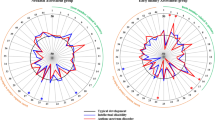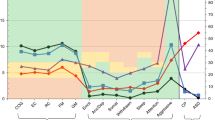Abstract
The relationship between a newborn score of minor physical anomalies (MPAs) and behavior at ages 1 and 2 was examined. From an initial screening population of 933, 63 high anomaly and 78 low anomaly infants were followed until age 2 by examiners blind for the newborn anomaly score. High anomaly infants were more likely to be temperamentally difficult as rated by parent interview and direct observation. A subgroup of six infants who were considered irritable at both ages 1 and 2 were all from the high anomaly group. However, there was little agreement between behavioral ratings across situations and over time, and there were no significant predictors of behavior problems at age 2 based on any newborn or 1-year measure. These results indicate that the newborn anomaly score by itself is unlikely to prove clinically useful in predicting preschool behavior problems for an unselected population. The usefulness of this measure for other, “high-risk,” populations remains to be explored.
Similar content being viewed by others
References
Bayley, N. Bayley scales of infant development. New York: Psychological Corp., 1969.
Behar, L. The preschool behavior questionnaire.Journal of Abnormal Child Psychology, 1977,5, 265–276.
Behar, L., & Stringfield, S. A behavior rating scale for the preschool child.Developmental Psychology, 1974,10, 601–610.
Buchan, B., Swap, S., & Swap, W. Teacher identification of hyperactive children in preschool settings.Exceptional Children, 1977,43, 314–315.
Bzoch, K. R., & League, R.Assessing language skills in infancy. Gainsville, Florida: Anhinga Press, 1971.
Carey, W. B. A simplified method for measuring infant temperament.Journal of Pediatrics, 1970,77, 188–194.
Carey, W. B. Clinical applications of infant temperament measurements.Journal of Pediatrics, 1972,81, 824–828.
Chamberlin, R. W. Can we identify a group of children at age 2 who are at high risk for development of behavior or emotional problems in kindergarten and first grade?Pediatrics, 1911,59, 971–981.
Frommer, E. A., & O'Shea, G. Antenatal identification of women liable to have problems managing their infants.British Journal of Psychiatry, 1973,123, 149–156.
Kohn, M., & Rosman, B. A social competence scale and symptom checklist for the preschool child: Factor dimensions, their cross-instrument generality and longitudinal persistence.Developmental Psychology, 1972,6, 430–444. (a)
Kohn, M., & Rosman, B. Relationship of preschool social-emotional functioning to later intellectual achievement.Developmental Psychology, 1972,6, 445–452. (b)
Lewis, M.Origins of intelligence in infancy and early childhood. New York: Plenum Press, 1976.
Nichamin, S. J. Recognizing minimal cerebral dysfunction in infant and toddler.Clinical Pediatrics, 1972,11, 255–257.
Peterson, D. R., Becker, W. C., Shoemaker, D. J., Luria, Z., & Hellmer, L. A. Child behavior problems and parental attitudes.Child Development, 1961,32, 151–162.
Quinn, P., & Rapoport, J. Minor physical anomalies and neurological status in hyperactive boys.Pediatrics, 1974,53, 742–747.
Quinn, P., Renfield, M., Burg, C., & Rapoport, J. Minor physical anomalies: A newborn screening and one year follow-up.Journal of the American Academy of Child Psychiatry, 1977,16, 662–669.
Rapoport, J., Prandoni, C., Renfield, M., Lake, C. R., & Ziegler, M. Newborn dopamine-β-hydroxylase, minor physical anomalies, and infant temperament.American Journal of Psychiatry, 1977,134, 676–678.
Rapoport, J. L., & Quinn, P. O. Minor physical anomalies (stigmata) and early developmental deviation: A major biologic subgroup of “hyperactive children.”International Journal of Mental Health, 1975,4, 29–44.
Richman, N., & Graham, P. A behavioral screening questionnaire for use with three year old children: Preliminary findings.Journal of Child Psychology and Psychiatry, 1971,12, 5–33.
Richman, N., Stevenson, J. E., & Graham, P. J. Prevalence of behavior problems in 3-year old children: An epidemiological study in a London borough.Journal of Child Psychology and Psychiatry, 1975,16, 277–288.
Schaefer, E. S., & Bayley, N. Maternal behavior, child behavior and their intercorrelations from infancy through adolescence.Monographs of the Society for Research in Child Development, 1963,28 (3, Serial No. 87).
Smith, D. W.Recognizable patterns of human malformation. Philadelphia: W. B. Saunders, 1970.
Steg, J., & Rapoport, J. Minor physical anomalies in normal, neurotic learning disabled and severely disturbed children.Journal of Autism and Childhood Schizophrenia, 1975,5, 299–307.
Thomas, A., Chess, S., & Birch, H. G.Temperament and behavior disorders in children. New York: New York University Press, 1968.
Waldrop, M., & Bell, R. Minor physical anomalies and inhibited behavior in elementary school girls.Journal of Child Psychology and Psychiatry, 1976,17, 113–122.
Waldrop, M., Bell, R., McLaughlin, B., & Halverson, C. Newborn minor physical anomalies predict short attention span, peer aggression, and impulsivity at age 3.Science, 1978,199, 563–565.
Waldrop, M., & Halverson, C. E. Minor physical anomalies and hyperactive behavior in young children. In J. Hellmuth (Ed.),The exceptional infant. New York: Brunner/Mazel, 1971.
Waldrop, M., Pedersen, F., & Bell, R. Q. Minor physical anomalies and behavior in preschool children.Child Development, 1968,39, 391–400.
Werry, J. Developmental hyperactivity.Pediatric Clinics of North Americas 1968,15, 581–598.
Author information
Authors and Affiliations
Additional information
Work done at Georgetown University School of Medicine was supported by a grant from the Easter Seal Research Foundation of the National Easter Seal Society for Crippled Children and Adults. The authors would like to thank John Bartko, Biometry Branch, NIMH, for advice on statistical analysis, and Frank Pederson, Social and Behavioral Sciences Branch, NICHD, Bethesda, Maryland, and Richard Q. Bell, Department of Psychology, University of Virginia, for helpful discussion of this work.
Rights and permissions
About this article
Cite this article
Burg, C., Hart, D., Quinn, P. et al. Newborn minor physical anomalies and prediction of infant behavior. J Autism Dev Disord 8, 427–439 (1978). https://doi.org/10.1007/BF01538048
Issue Date:
DOI: https://doi.org/10.1007/BF01538048




